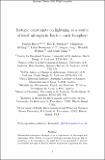Isotopic constraints on lightning as a source of fixed nitrogen in Earth’s early biosphere
Date
01/06/2023Author
Grant ID
RGS\R1\211184
NE/V010824/1
860470
Keywords
Metadata
Show full item recordAbstract
Bioavailable nitrogen is thought to be a requirement for the origin and sustenance of life. Before the onset of biological nitrogen fixation, abiotic pathways to fix atmospheric N2 must have been prominent to provide bioavailable nitrogen to Earth’s earliest ecosystems. Lightning has been shown to produce fixed nitrogen as nitrite and nitrate in both modern atmospheres dominated by N2 and O2 and atmospheres dominated by N2 and CO2 analogous to the Archaean Earth. However, a better understanding of the isotopic fingerprints of lightning-generated fixed nitrogen is needed to assess the role of this process on early Earth. Here we present results from spark discharge experiments in N2−CO2 and N2−O2 gas mixtures. Our experiments suggest that lightning-driven nitrogen fixation may have been similarly efficient in the Archaean atmosphere, compared with modern times. Measurements of the isotopic ratio (δ15N) of the discharge-produced nitrite and nitrate in solution show very low values of −6‰ to −15‰ after equilibration with the gas phase with a calculated endmember composition of −17‰. These results are much lower than most δ15N values documented from the sedimentary rock record, which supports the development of biological nitrogen fixation earlier than 3.2 billion years ago. However, some Paleoarchean records (3.7 billion years ago) may be consistent with lightning-derived nitrogen input, highlighting the potential role of this process for the earliest ecosystems.
Citation
Barth , P , Stueeken , E E , Helling , C , Rossmanith , L , Peng , Y , Walters , W & Claire , M 2023 , ' Isotopic constraints on lightning as a source of fixed nitrogen in Earth’s early biosphere ' , Nature Geoscience , vol. 16 , pp. 478-484 . https://doi.org/10.1038/s41561-023-01187-2
Publication
Nature Geoscience
Status
Peer reviewed
ISSN
1752-0894Type
Journal article
Description
Funding: P.B. acknowledges a St Leonard’s Interdisciplinary Doctoral Scholarship from the University of St Andrews. E.E.S. acknowledges funding from a Royal Society research grant (RGS\R1\211184) and from a NERC Frontiers grant (NE/V010824/1). Ch.H. is part of the CHAMELEON MC ITN EJD which received funding from the European Union’s Horizon 2020 research and innovation programme under the Marie Sklodowska-Curie grant agreement number 860470.Collections
Items in the St Andrews Research Repository are protected by copyright, with all rights reserved, unless otherwise indicated.

